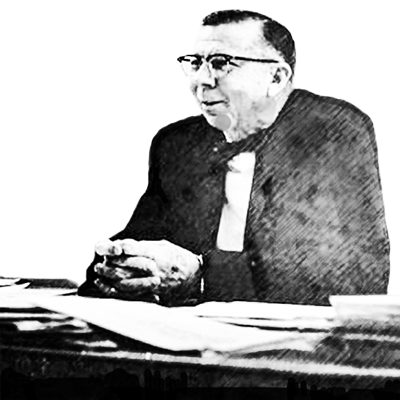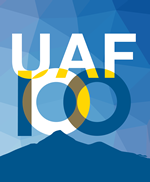C.T. Elvey

Christian Thomas "C.T." Elvey was lured to the University of Alaska over an early morning cup of tea, even though he didn't like the "damn stuff."
In the early 1950s, UA President Terris Moore was looking for a permanent GI director after the first director resigned. So William Wilson, the institute's interim director, invited Elvey to a science conference in Fairbanks and arranged for Elvey to stay his home the same night that Sydney Chapman was visiting. Chapman, a world-famous space scientist formerly of Oxford University, had recently joined the Geophysical Institute.
Elvey wrote later that, being a light sleeper, he heard Chapman tiptoe out of their shared room early the next morning. "Before long, he returned bearing a teapot and two cups," Elvey recalled. "I was being served tea in bed by Sydney Chapman!"
The story, told in Neil Davis' book "The College Hill Chronicles," explained how Elvey in 1952 came to be the second permanent director of the UAF Geophysical Institute, bringing with him an already considerable reputation as a geophysicist and astronomer.
Elvey had studied stars at several prestigious laboratories and universities before coming to Fairbanks. "His work in spectroscopy strongly contributed to understanding stellar atmospheres and stellar rotation," according to the 2007 edition of the Biographical Encyclopedia of Astronomers.
In Fairbanks, Elvey turned to studying the aurora. He and Chapman started the master's and doctorate programs in geophysics.
Elvey became a popular figure in Fairbanks, Davis said. That's because, even though sophisticated and urbane, he had an obvious fear of public speaking that he forced himself to overcome by addressing community groups, Davis said.
"The man up there talking so knowledgeably about the work of the Geophysical Institute was just like everybody else, unsure and sometimes scared as hell," Davis wrote. "The audiences loved it, as well they should, for Elvey never talked down to anyone, he just shared his knowledge. Alaskans liked that."
Others remembered Elvey with less fondness, including William Pruitt, a biology professor who studied the area where the Atomic Energy Commission wanted to excavate a harbor in northwest Alaska with nuclear blasts. In 1962, Pruitt met with Elvey, who by then was the university's vice president of research. According to Dan O’Neill’s book "The Firecracker Boys," Pruitt objected to the way his critical report to the commission had been handled, and the dispute had gotten him fired. Elvey said the university couldn't risk losing the AEC's funding, Pruitt claimed. "He was nasty," Pruitt wrote at the time.
Elvey served as the Geophysical Institute director until 1963. He retired in 1967. After his death in 1970, a crater on the far side of the moon was given his name.
More online about C.T. Elvey:
- A profile on the UA Journey website
- A biography in the Biographical Encyclopedia of Astronomers
- A brief description of the moon crater named for Elvey


